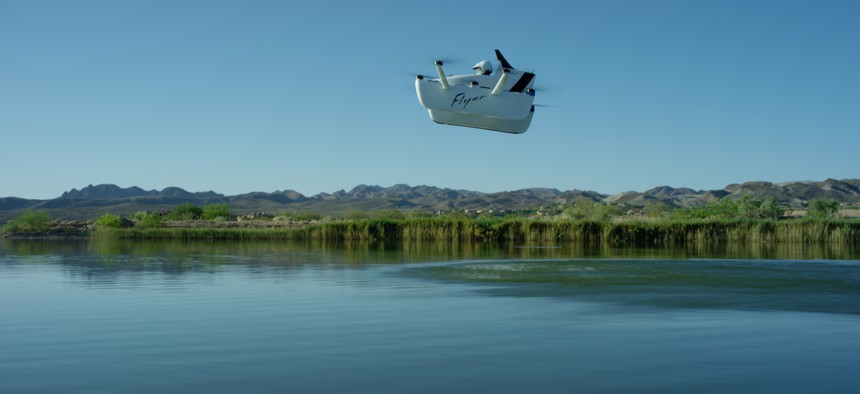Google’s Larry Page Thinks We’ll Soon Be Soaring Over Traffic in These Cute Flying Cars He’s Building

A Flyer personal aircraft cruises above a body of water. Kitty Hawk
For now, the Flyer is clearly a novelty, meant to appeal to the ambitions and pocketbooks of wealthy hobbyists.
On a recent, brutally hot morning on the edge of a lake just outside Las Vegas, tech entrepreneur Carter Reum was strapped into his vehicle and ready to lift off into the future. Except he didn’t.
Reum was sitting inside the narrow cockpit of the Flyer, a ten-propeller flying vehicle designed and built by Kitty Hawk, a company started by Google’s Larry Page. It was to be Reum’s inaugural flight in the vehicle after becoming the first person to buy one. (Kitty Hawk would not disclose the price).
But it was not to be. Kitty Hawk’s flight crew, sitting in a white, yurt-like enclosure, scrapped the flight after wind speeds climbed above ten knots. Reum would have to wait another day.
Just a few minutes before, however, flight training manager Brittney Miculka had been at the helm of the Flyer, lifting off from the edge of a pier, rising ten feet above the lake and performing impressive turns and pivots in front of a small group of onlookers. The flight lasted about eight minutes, but in that short time, observers caught a glimpse of what the future might look like; one where the average person will no longer be stuck in soul-crushing traffic, but soaring above it.
“The vision of Kitty Hawk is truly to free the world from traffic,” Todd Reichert, Kitty Hawk’s lead engineer, told Quartz. “It’s incredibly ambitious, and it will take time, and this is the first step.”
The Flyer looks a lot like a hobbyist’s drone. It runs on batteries and can stay aloft for around 20 minutes. Its rotors are large, making it more energy efficient and less noisy, says Reichert. Indeed, from 50 feet away or so, the Flyer sounds no louder than a semi-truck on the highway. Whether that’s going to be too loud when it’s flying over your house is an open question.
It’s easy to get caught up in the hype around flying cars. But the technology does seem close, even if none of these vehicles have yet gone through the kind of rigorous testing that’s going to be required to ensure passenger safety. More important, perhaps, or at least, more difficult to surmount, will be the vast changes to the regulation of federal airspace that will be required before flying cars become common.
Kitty Hawk is not the only company trying to make flying cars. Companies in China, Germany, Slovakia and elsewhere have been developing flying cars for several years now. But few of them have reached the stage where someone without a pilot’s license could sit inside the vehicle and fly.
Mostly that has to do with the Flyer’s design. It weighs just 250 pounds, thus classifying it under FAA rules as an ultralight, which means no aircraft registration or pilot certification are required. It also means that it won’t be able to fly over congested areas, like cities.
The Flyer is flown with just two controls: one switch to set the altitude, and a small joystick to change direction.
For now, the Flyer is clearly a novelty, meant to appeal to the ambitions and pocketbooks of wealthy hobbyists.
After his scuttled flight, standing in the Kitty Hawk hangar and surrounded by four other Flyer vehicles, Mr. Reum was gushing with the techno-optimism of many early adopters: “Don’t forget, five or six years ago, it was hard to imagine a world where you’d rent out your house or apartment,” he said. “So once people get the idea that this is the future, I see no reason why this won’t be prevalent in the next few years.”





